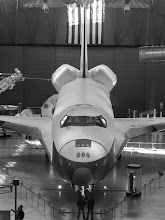President Obama unveiled his space plan for the second time this year. The first you were only likely to catch if you are a policy wonk and read the budget release or if your a space geek. If you are a like me and happen to be a space policy geek you may have caught it both times and on both occassions were left with a stale taste in your mouth.
The AP report (use link above) described the speech as reminiscent of President Kenney's 1961 speech before Congress. I was not in the House camber in 1961, okay I'll confess that I wasn't even alive, but let's realistically think about this. At the time Kennedy made his speech the United States had a grand total of 15 minutes in space and Kennedy was daring NASA and the country to put a man on the moon in nine years. The majority of the Kennedy Space Center Infrastructure didn't even exist. 40 years, 6 moon landings, and an international space station later and people are comparing Obama's speech in Florida one of the most famous space speeches of all time??
I'll agree with my former professor quoted in the piece, "the president said all the right things." Professor Logsdon really ought to know better (perhaps it was omitted from the piece) in fifteen months we have all leaned that President Obama can give a nice speech. Here's the thing, I do expect more of my president - I expect him to be a man of action.
Perhaps the AP should hold off on proclaming Mr. Obama as reminiscent of Mr. Kennedy - perhaps we should postpone accolades until we have more than a speech to celebrate and another anniversary to mark.
It's a Small World... Don't Burn Bridges
16 years ago



